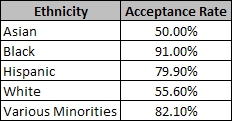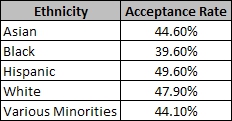As seven out of eight black applicants to medical school receive affirmative action and bring grades and test scores below that of the average white person refused admission to medical school, the brusque observation of the flight attendant was reasonable.
Black doctors get sued for malpractice at a much higher rate than other doctors. Going to a random black doctor is not usually a smart move unless you really want an affirmative action doctor and that kind of expertise.
Dr. Tamika Cross, a black physician at the Lyndon B. Johnson Hospital in Houston, could not immediately come to the phone on Friday. She was busy delivering a baby boy by C-section.
So, yes, in case anyone has any doubt, Dr. Cross is an “actual physician.”
But the 28-year-old doctor said that was the question hanging in the air, raised by a flight attendant, when she volunteered to treat a sick passenger on a Delta flight from Detroit to Minneapolis on Sunday.
From the website Medical School Success:
A common question many medical school applicants ask is, “How hard is it to get into medical school?”
According to the Association of American Medical Colleges (AAMC), there were 42,742 applicants vying for a spot in the entering class of 2010 – 2011. Each applicant sent out an average of 14 applications. And even with all that work, only 40-something percent of the applicants were accepted into medical school.
So my answer is that getting into medical school is pretty darn difficult.
If you take a look at the medical school requirements page, you can see that I recommend a GPA of at least 3.5 and a MCAT score of at least 30. With these scores, you should have a chance to get into medical school.
However, your chance for getting in also depends on the color of your skin.
Medical School Looks at Your GPA, MCAT Score, and … Ethnicity?!
I have always had a suspicion that the standards are not universal, but instead, adjusted to which group or ethnicity an applicant fits into. I do not expect medical schools to blatantly say, “If you are a minority, we make it easier for you to get in. If you are not a minority, we make it tougher for you to get in.” That would not be very good for public relations. But never in my life would I have expected the data to be out in the open. But it is!
AAMC has provided data on medical school applicants’ GPA, MCAT score, and ethnicity. (As of May 2012, the data are for 2009 – 2011. If you access the link at the later date, the years and the subsequent data may have changed.) AAMC did not right-out say that minorities have lower standards for admissions (it does not have one table comparing all the different ethnicities), but it gives data to arrive at that conclusion.
What Are Your Chances with a GPA of 3.5 and a MCAT Score of 30?
The very first thing I did was to compare the acceptance rates of each ethnicity with a GPA of 3.5 and a MCAT score of 30. I am recommending these as the minimum acceptable numbers, but how effective are they? The results are actually quite shocking.
Various minorities are American Indian, Alaska Native, Black, or Hispanic.
Table 1 – Acceptance Rate by Ethnicity for Applicants with GPA of 3.40 – 3.59 and MCAT of 30 – 32 for 2009 – 2011
If you are black, you are pretty much guaranteed a spot in medical school. But if you are Asian, your chance of getting in could very well be based on the flip of a coin. Heads, you are accepted. Tails, you are rejected.
For some reason, Asians have a slightly worse probably of getting in compared to Whites. My guess is that a disproportionally large amount of Asians (compared to its makeup of the general population) is applying to medical school. So if Asians make up 10% of the total US population, maybe 20% of the total applications come from Asians.
So I quickly jumped to the US Census Bureau and found the percentage each ethnicity makes up in the total US population in 2010. I then compared that to the percentage each ethnicity makes up in medical school applications.
Table 2 – Percent of Population vs Percent of Applicants by Ethnicity
As I suspected, a disproportionate amount of Asians are applying to medical schools. They make up less than 5% of the population and yet comprises of more than 20% of the medical school applicants! Hispanics are very under-represented in terms of medical school applicants.
Are Medical Schools Reluctant to Accept Asians?
Since so many Asians are applying, medical schools are in a quandary. Should they make it very hard for Asians to get in, so the percentage of Asian US medical students reflects that of the US population? Or should they take the applicants regardless of color?
To determine the answer to the question, I looked at the acceptance rate of each group, which is shown below:
Table 3 – Acceptance Rate by Ethnicity for 2009 – 2011
It seems that the acceptance rate of each ethnicity is roughly the same, 40-something percent. Medical schools are not reluctant to accept Asians. If medical schools wanted the student population to reflect the US population, Asian acceptance rates would be a lot lower than 40%. What is quite unexpected is that the lowest acceptance rate does not go to Asians, but to the Blacks.
Why Are Blacks Less Likely to Get into Medical School?
So far, it makes no sense. There is a disproportionately large amount of Asians applying to medical school. There is a disproportionately small amount of Blacks applying to medical school. And yet, Asians have a higher acceptance rate than blacks. Why?
I decided to look at the average (mode and median) GPA and MCAT score of each ethnicity. Maybe that will explain why.
Table 4 – Average (Mode) and Its Acceptance Rate by Ethnicity for 2009 – 2011
The mode is basically the largest group. So if there are three groups (A, B, and C), and if group A has 5 people, group B has 6 people, group C has 10 people, the mode is group C.
Based on the mode, Whites have the best scores and Blacks have the worst scores.
Table 5 – Average (Median) and Its Acceptance Rate by Ethnicity for 2009 – 2011
The median is basically the middle person. If one guy is 5 years old, another guy is 10 years old, and the last guy is 100 years old, the median age is 10 years old.
Based on the median, Asians and Whites have the best scores and again, Blacks have the worst scores.
If you take a look at the acceptance rates for both Table 4 and Table 5, you will see that on average, Blacks have a lower acceptance rate because of their poor scores.
This means that GPA and MCAT scores matter a lot. You cannot make up for it just by being a minority.
GPA and MCAT Score that Guarantees Acceptance
In Table 1, I have established that the acceptance rate depends not only on GPA and MCAT score but also on your ethnicity. Therefore, I am not satisfied with a 3.5 GPA and 30 MCAT as a baseline goal to get into medical school.
I want to give you a targeted goal, based upon which group you fall into. This goal will practically guarantee a spot in medical school. If you can hit these numbers, you have around 80% of getting accepted.





